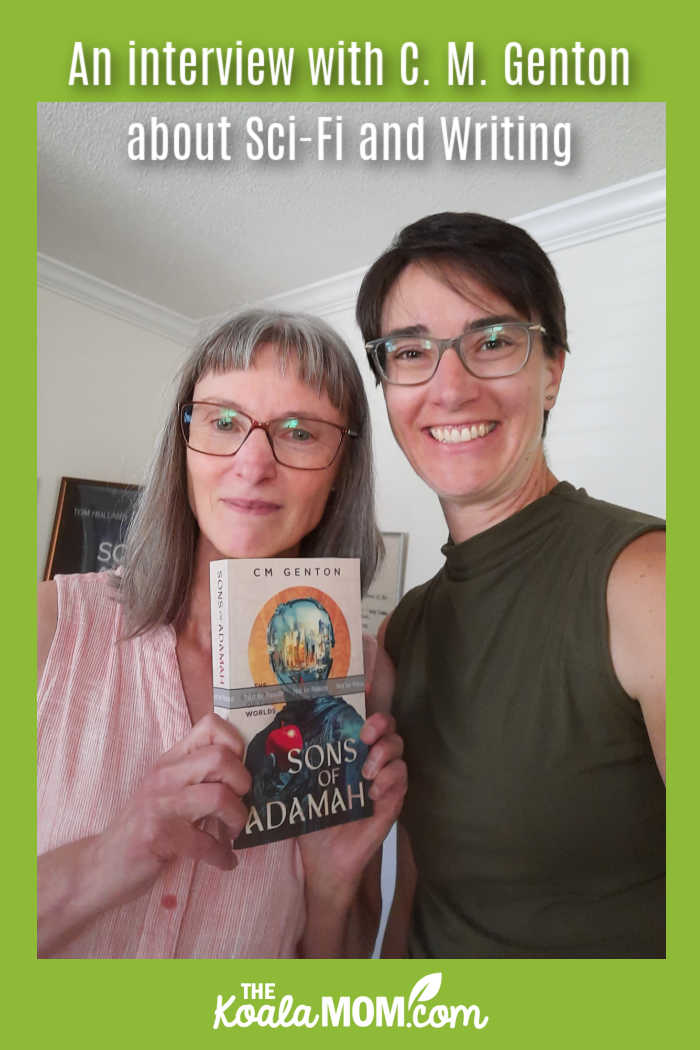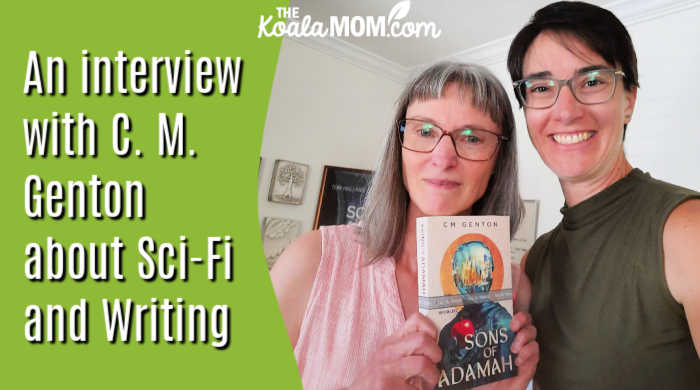When I showed up at C. M. Genton’s book launch party, a few other guests asked how I knew Catherine. “Ummm,” I began. How do I know her? We’ve been emailing each other sporadically for several years about writing and books and sometimes other topics. After some chitchat, Catherine and I decided she’d somehow found my blog and reached out and we’ve been “online” friends since. This summer, it was a delight to meet Catherine “in real life” to celebrate the re-release of her first novel, Sons of Adamah.
From my review: Genton writes a fast-paced sci-fi novel that raises interesting questions about what the future may look like. While Andropida follows strict gender laws, where men and women each have specific roles in the colony, earth has abandoned gender altogether and everyone goes by the neutral pronouns zhe/zher. Those who hold to “trad” values are looked down upon and barred from advancement in society, while “rebels” exist in areas outside civilization.
After appetizers and bubbly, Catherine shared some of her ups and downs in writing her novel and preparing its relaunch. Sons of Adamah now has a new cover and has gone through some editing, as it has been freed from the constraints of being a thesis project. I’m excited to give it a second read. In the meantime, I enjoyed chatting with Catherine about her novel, sci-fi, and more.

This post contains affiliate links; as an Amazon associate, I earn from qualifying purchases.
TKM: Tell us a bit about yourself.
Catherine: I’m the ninth and last child in a French immigrant family in B.C., Canada. I was raised Catholic and wouldn’t trade that for anything in the world. My primary vocation has been Mom to my remarkable children, who are now all grown. My favourite thing to do is have the grandkids over. It’s an excuse for silly time.
TKM: Tell us a bit about Sons of Adamah.
C. M. Genton: Sons of Adamah is the first in a series of apocalyptic sci-fi novels. The main character, John, is a young man struggling to find his identity between two settings: gender-neutral Earth and a rigid patriarchal galactic colony, while uncovering a vast conspiracy.
TKM: What inspired you to write Sons of Adamah?
Catherine: Sons of Adamah is my protest to the effacing of the intrinsic meaning/value of Man and Woman. It’s also my love letter to my children and grandchildren, to fuel their hunger for the good, the beautiful, and the true. I developed the novel in seminary to accompany my theological work: “The Narrative and Iconography of Gender and Sexuality.”
TKM: How did you decide whose point of view to tell Sons of Adamah from?
Catherine: It seems to me that men are becoming disadvantaged and disenfranchised. So I chose John as my main character, a young man who has to rise up despite his various problematic cultures.
TKM: Is your main character at all like you? (Or any other characters?)
Catherine: I had difficulty creating John because I don’t know how men think and feel. Initially, John was passive, as I tend to be. Then my manuscript accessor prodded me to make John more combative and volatile, which is unlike me. It was hard, and the fictional result is a bit reductive, but I trust John’s ramped up emotions/behaviors dramatize some reality.
My female characters are more like me, especially Ann and her frustration with limitations, but also Wymry who engages in devastating experimentation. I’m looking forward to writing from a woman’s point of view in Daughters of Adamah.
TKM: Who is your favourite author and why?
C. M. Genton: Like many Christians, my answer is C.S. Lewis. I’ve read many of his books and often re-read his Narnia series and his Space Trilogy. His deep immersion in ancient literature/cultures enabled him to bridge the ancient mythological worldview and our growing secular one. (Secular = blindness to the forces within and around us.) Lewis writes rocking good fiction that happens to also protest damaging cultural meta-narratives. For example, The Last Battle, That Hideous Strength, and Pilgrim’s Regress are his protests against scientism and materialism.
TKM: What was the most challenging part of writing Sons of Adamah, and how did you overcome that?
Catherine: I had written only short pieces for my Creative Writing undergrad program, so creating on the scale of a novel was daunting. Over hundreds of pages, I had to build a narrative shape, interwoven with backstory and characters arcs, all with believable tensions and consistent themes. I originally intended Sons of Adamah to be a stand-alone novel, but it grew too long and required a sequel. Then several sequels! I couldn’t create on such a scale without input from readers or my editors.
TKM: What was the most fun or exciting part of writing?
Catherine: World-building is the most fun. That’s where I get to create, destroy, and redeem characters, cultures, and planets. The most exciting part is hearing from readers.
TKM: Can you speak to using a gender-neutral name when writing a novel about gender?
Catherine: Gender-neutral is a rather painful term, but yes, I intentionally obscured my female name. Most sci-fi is written by and for men, so, being a new author, I didn’t want to deter the typical reader from trying my book just because I’m a woman. Not very loud-and-proud of me. The differential is easing, but still, I have such a fluffy name. I intend to play hardball in this big boys’ game.
TKM: What advice would you give to a writer starting out?
C. M. Genton: For various reasons, I craft my fiction slowly, so I can only advise new writers who will prioritize craft over rapid production. The following list isn’t linear, however, nor does it include the regular rest periods most authors need.
- Play with seed ideas and half-baked concepts. Follow those bunny trails and write ridiculous and impossible things. This playground is for your eyes only. Then brainstorm the bits and threads that especially haunt you.
- Write the ugly draft. Or, several ugly drafts, if necessary. Learn to love your “ugly babies.”
- Read and re-read books about the craft of writing. One of my favourites is On Writing by Stephen King.
- Develop your story as much as you can, keeping your “intuitive flow” foremost. For the nitty gritty, Writing Deep Viewpoint by Kathy Tyers is helpful. (Disclosure: Tyers was my technical advisor in seminary.)
- Solicit feedback from friends, family, and writers’ communities. Gracious folk will build your confidence; the blunt ones will build your skill.
- When you’ve gone as far as you can, hire editors. I recommend a manuscript assessment, then a developmental editor. Finally, copy/line editor, then proofreader. The best editors are blunt. Some brilliant and experienced writers short-cut this process, but I doubt I ever will.
Ultimately, you’re building a lifestyle and a community, along with the creative and technical skills. This lifestyle includes reading books in your preferred genre and well-crafted books of any genre, and noting what you love about them. (“Best-selling” is not synonymous with “well-crafted.”) Keep in mind your capabilities are probably greater than you know, and you’re probably more resilient too. Times of discomfort, disappointment, and stretching are necessary for growth.
For more insight, my website blog, For Writers, explores various aspects of the creative life, including all the dumb mistakes I’ve made. (The other is Sci-fi Reviews, by my daughter, a retired Air Force Captain and seminarian.)

TKM: Where is your favourite place to write?
Catherine: My favourite spot is a desk in front of glass doors in my writing/sewing/guest room. From there, I see the evergreens and the chipmunk shenanigans.
TKM: Do you have another novel in the works?
Catherine: Two sequels: Daughters of Adamah (sequel) and Cities of Adamah (backstory). The final novel (I think) will be Children of Adamah. Then, perhaps a collection of short stories related to the Adamah world. All by God’s grace.
TKM: How can readers keep up with you and your books?
Catherine: Readers are welcome to subscribe through cmgenton.ca. My newsletters aren’t overly long, nor are they frequent—every four to six weeks between events and launches. I have a lot of fun crafting them and aim for high interest and entertainment.
Readers may also email me at [email protected].

No Responses Yet